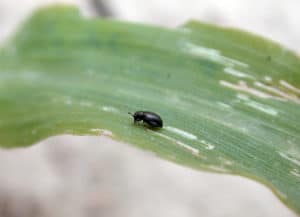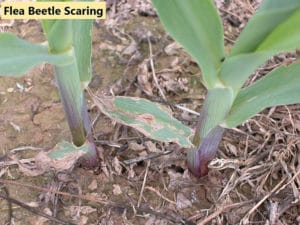 Several species of flea beetles may occasionally cause economic damage, with the corn flea beetle being the most common. Adults are small (1/16 inch), shiny black beetles known for their ability to jump long distances when disturbed. Corn flea beetles injure corn by removing leaf tissue and transmitting the bacterium Erwinia stewartii, which causes Stewart’s wilt. Beetles feed on the upper and lower sides of corn leaves causing scarring that may appear whitish or silvery.
Several species of flea beetles may occasionally cause economic damage, with the corn flea beetle being the most common. Adults are small (1/16 inch), shiny black beetles known for their ability to jump long distances when disturbed. Corn flea beetles injure corn by removing leaf tissue and transmitting the bacterium Erwinia stewartii, which causes Stewart’s wilt. Beetles feed on the upper and lower sides of corn leaves causing scarring that may appear whitish or silvery.
Sampling: Begin scouting corn for scarring from flea beetles when seedlings emerge. Flea beetles will often first appear around field edges as they move from grassy areas and other overwintering sites.
Treatment Thresholds: Treat seedling plants with five or fewer leaves when 75 percent of the plants show obvious scarring by beetles on stems and leaves. Insecticide seed treatments and some other at-planting insecticides typically provide adequate protection from flea beetles.
Management options
| Insecticide (Trade Names) for FLEA BEETLES | Lb Active Ingredient per Acre | Amount Formulation per Acre | Performance Rating |
| bifenthrin (Brigade 2E, Discipline 2E, Fanfare 2E) | 0.047 - 0.1 | 3 - 6.4 oz | 6 |
| carbaryl (Sevin XLR Plus 4) | 1 - 2 | 32 - 64 oz | 8 |
| esfenvalerate (Asana XL 0.66E) | 0.03 - 0.05 | 5.8 - 9.6 oz | 6? |
| permethrin (Pounce 3.2E) | 0.1 - 0.2 | 4 - 8 oz | 5? |
| β-cyfluthrin (Baythroid XL 1) | 0.006 - 0.0125 | 0.8 - 1.6 oz | 6 |
| γ-cyhalothrin (Declare 1.25) | 0.01 - 0.015 | 1.02 - 1.54 oz | 6 |
| λ-cyhalothrin (Warrior II) | 0.02 - 0.03 | 1.28 - 1.92 oz | 6 |
| Z-cypermethrin (Mustang Maxx 0.8E) | 0.017 - 0.025 | 2.75 - 4 oz | 6 |

